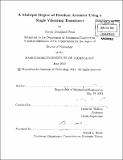| dc.contributor.advisor | David R. Wallace. | en_US |
| dc.contributor.author | Penn, James Douglass | en_US |
| dc.contributor.other | Massachusetts Institute of Technology. Dept. of Mechanical Engineering. | en_US |
| dc.date.accessioned | 2012-11-19T19:17:28Z | |
| dc.date.available | 2012-11-19T19:17:28Z | |
| dc.date.copyright | 2012 | en_US |
| dc.date.issued | 2012 | en_US |
| dc.identifier.uri | http://hdl.handle.net/1721.1/74908 | |
| dc.description | Thesis (Ph. D.)--Massachusetts Institute of Technology, Dept. of Mechanical Engineering, 2012. | en_US |
| dc.description | Cataloged from PDF version of thesis. | en_US |
| dc.description | Includes bibliographical references (p. 127-129). | en_US |
| dc.description.abstract | Multiple degree of freedom actuation typically requires one actuator for each degree of freedom, where each actuator requires its own heavy and expensive transducer to transform an electrical input signal into a useful mechanical output. Mechanisms can be used to split the output of a single motor, but the resulting systems are often complex, large, heavy, and noisy. Some also lack true independence of outputs. This thesis develops and demonstrates a novel system for multiple degree of freedom actuation using a single transducer to achieve independent, bi-directional control of multiple degrees of freedom. The resulting system is mechanically simple, compact, lightweight, easy to control, and potentially inexpensive. The Multiple Degree of freedom Actuator (MDA) comprises i) a single vibrating transducer and ii) a parallel network of resonators. Each resonator is tuned to its own unique resonant frequency and drives its own degree of freedom. First, it is shown that the MDA can actuate independently multiple degrees of freedom with a single transducer by selectively exciting the resonant frequencies of one or more resonators, which then drive their respective degrees of freedom. Both numerical simulation and physical prototypes are used to verify the results. Second, a simple, compact resonator/rectifier mechanism is developed and fabricated using flexures that convert oscillating motion of a resonator to useful, continuous, bi-directional rotation of an output rotor without crosstalk between outputs. Third, the theoretical efficiency of the MDA, driven by an electromagnetic transducer, is derived. An efficient, low-moving-mass moving magnet transducer is developed and shown to greatly improve theoretical system efficiency. Finally, a hypocycloid speed reducer mechanism is developed and fabricated to achieve a very high reduction ratio in a compact package with greater simplicity and improved performance. | en_US |
| dc.description.statementofresponsibility | by James Douglass Penn. | en_US |
| dc.format.extent | 129 p. | en_US |
| dc.language.iso | eng | en_US |
| dc.publisher | Massachusetts Institute of Technology | en_US |
| dc.rights | M.I.T. theses are protected by
copyright. They may be viewed from this source for any purpose, but
reproduction or distribution in any format is prohibited without written
permission. See provided URL for inquiries about permission. | en_US |
| dc.rights.uri | http://dspace.mit.edu/handle/1721.1/7582 | en_US |
| dc.subject | Mechanical Engineering. | en_US |
| dc.title | A Multiple Degree of Freedom Actuator using a single vibrating transducer | en_US |
| dc.title.alternative | MDA using a single vibrating transducer | en_US |
| dc.type | Thesis | en_US |
| dc.description.degree | Ph.D. | en_US |
| dc.contributor.department | Massachusetts Institute of Technology. Department of Mechanical Engineering | |
| dc.identifier.oclc | 815449175 | en_US |
